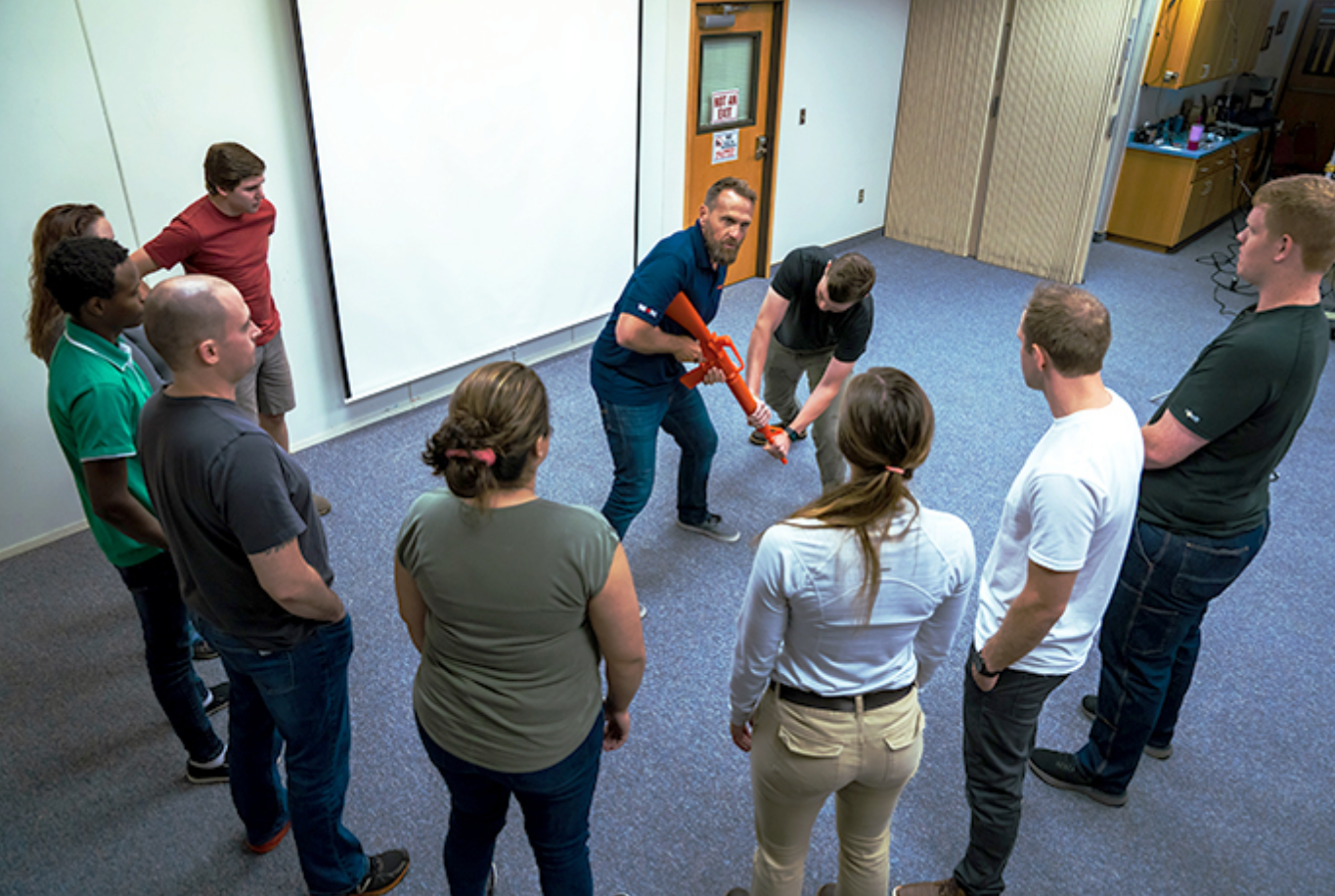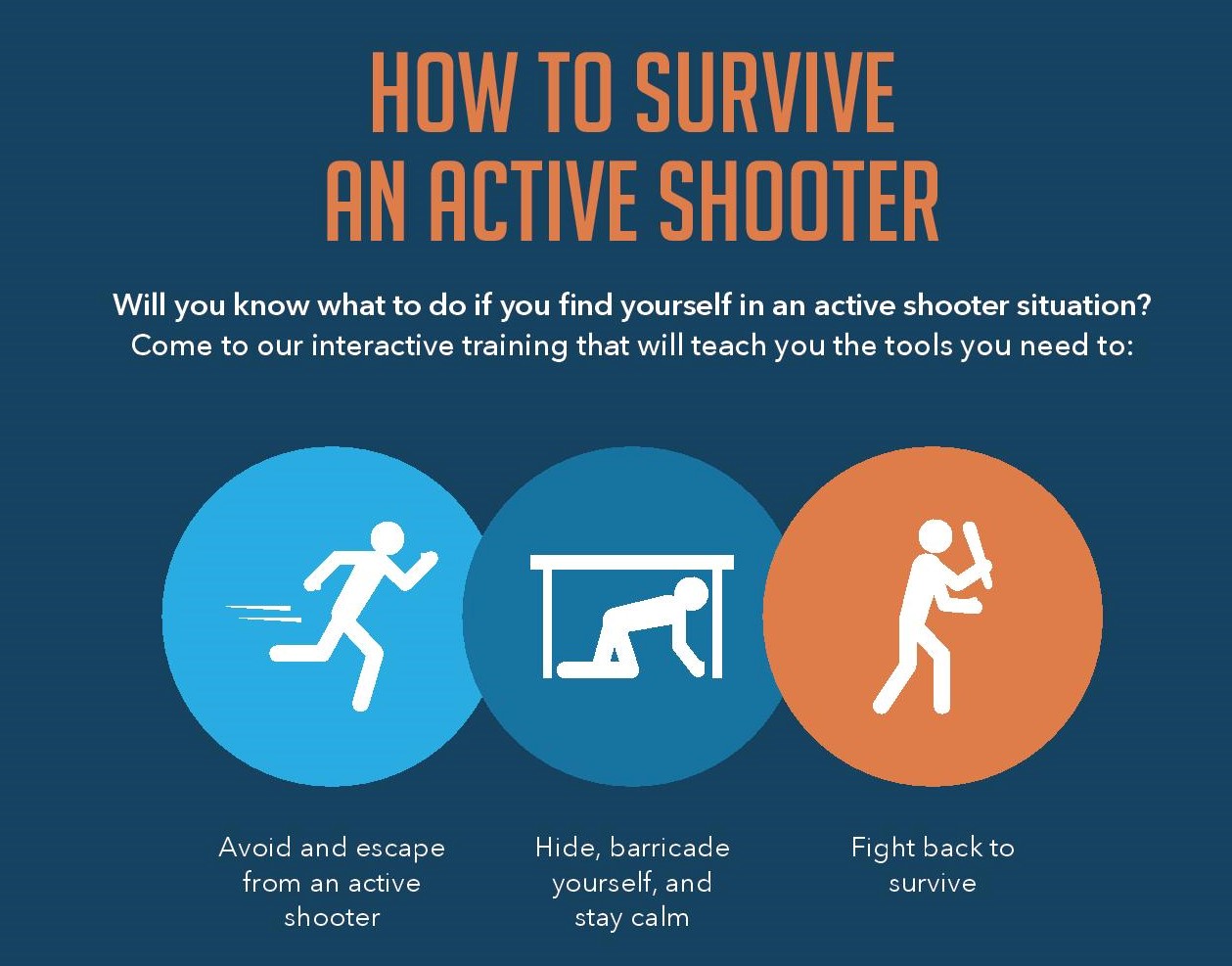Finest Practices for Implementing Active Shooter Training in Your Firm
Finest Practices for Implementing Active Shooter Training in Your Firm
Blog Article
Implementing Energetic Shooter Training: Best Practices for Producing a Safe and Prepared Area Atmosphere
As communities confront the upsetting fact of energetic shooter events, the application of detailed training programs comes to be critical. An effective approach rests on not just the advancement of customized curricula that resolve neighborhood threats yet additionally the participation of varied stakeholders. By utilizing a range of training approaches, neighborhoods can make sure that all members are furnished with important abilities. However, the challenge depends on maintaining a flexible structure that progresses with emerging threats. What are the critical elements that can change a standard training program into a durable model for neighborhood durability?

Understanding the Need for Training
In an age marked by increasing cases of violence in public spaces, comprehending the demand for active shooter training has never been a lot more essential. The frequency of mass shootings across different environmentsâEUR" such as institutions, offices, and buying centersâEUR" highlights the urgency for people and organizations to be gotten ready for such emergency situations. Energetic shooter circumstances can unfold rapidly, leaving little time for people to respond efficiently. Therefore, comprehensive training efforts can equip participants with the knowledge and skills to respond emphatically.
Training promotes a sense of empowerment and preparedness, enabling individuals to really feel more safe and secure in their surroundings. The benefits of active shooter training extend beyond prompt response; they consist of enhancing interaction procedures and boosting general safety and security steps within organizations.
Trick Parts of Effective Programs
Effective active shooter training programs include several crucial elements that enhance readiness and reaction capacities. Initially, comprehensive educational program growth is important, guaranteeing that training content is relevant, evidence-based, and tailored to the certain demands of the organization or community. This consists of comprehending the dynamics of energetic shooter occurrences and the mental influence on individuals included.
2nd, sensible training situations ought to be used to simulate prospective circumstances, permitting individuals to exercise decision-making and response techniques in a regulated atmosphere. These drills promote muscle mass memory and develop confidence amongst individuals.
Third, a concentrate on interaction protocols is important. Developing clear lines of communication amongst law enforcement, emergency situation -responders, and individuals makes sure collaborated feedbacks during an event. Regular updates and refresher programs help keep interaction pathways clear and efficient.
4th, recurring analysis and responses devices need to be incorporated into the training program - active shooter training. Assessing the performance of training with participant comments and performance metrics permits continuous enhancement
Lastly, fostering a society of security and readiness within the neighborhood encourages watchfulness and positive actions, making sure that individuals are not just qualified but also participated in keeping a safe setting.
Engaging Community Stakeholders

To efficiently engage these stakeholders, it is necessary to connect the goals and advantages of the training. Holding educational sessions can aid clear up the training's objective, address issues, and outline the roles each stakeholder might play. Developing a stakeholder consultatory board can help with recurring dialogue, enabling for varied point of views and understandings to be incorporated into the training program.
Structure relationships with neighborhood leaders and companies is likewise essential. Their assistance can enhance outreach efforts, increase involvement, and guarantee that training is customized to the distinct needs of the area. In addition, stakeholders can aid in disseminating information and resources, reinforcing the message of security and readiness.
Ultimately, engaging community stakeholders not only reinforces the training campaign yet additionally grows a feeling of possession among citizens, leading to an extra resistant and informed neighborhood with the ability of reacting effectively to potential risks.
Educating Distribution Approaches
Using a variety of training distribution approaches is important to accommodate the diverse discovering styles and needs of participants in active shooter training programs (active shooter training). Reliable training can take numerous forms, including talks, hands-on simulations, on the internet modules, and interactive workshops. Each technique serves a distinct objective and can improve the general discovering experience

On-line modules supply adaptability and accessibility, allowing individuals to learn at their very own pace. These can consist of videos, quizzes, and discussions to evaluate understanding. Interactive workshops urge seminar and problem-solving, advertising team effort and communication skills.
Incorporating a combined strategy that combines these techniques not only enhances the training experience yet also makes certain that individuals are better prepared to react effectively in case of an active shooter circumstance (active shooter training). By attending to various discovering choices, companies can develop a much more educated and receptive neighborhood
Continual Assessment and Renovation
Routine evaluation you could check here and enhancement of energetic shooter training programs are important to keeping their relevance and effectiveness. As risks progress, so should the techniques and methods employed in training. Continual analysis makes sure that training material mirrors the current intelligence on energetic shooter occurrences, including lessons discovered from current occasions and adjusting for arising patterns.
To facilitate this procedure, organizations must establish feedback devices that include individual evaluations, professional evaluations, and case debriefs. Gathering information on individual efficiency during drills and exercises is necessary, as it highlights areas requiring renovation and educates future training sessions. Additionally, engaging with legislation enforcement and emergency situation -responders can give important insights into the functionality and applicability of training methods.
On a regular anchor basis scheduled evaluations of training materials and techniques must be mandated, fostering a setting of technology and flexibility. Organizations should also urge a society of continuous understanding, where personnel feel empowered to suggest adjustments based on their experiences. By committing to constant analysis and improvement, organizations not only improve the efficiency of their active shooter training programs yet also enhance their overall dedication to security and preparedness within the neighborhood.
Verdict
In conclusion, effective implementation of energetic shooter training requires a comprehensive method that focuses on neighborhood engagement and realistic simulations. By developing customized curricula, including varied training methods, and promoting partnership among stakeholders, areas can enhance readiness. Continuous assessment and feedback systems are vital for adapting programs to emerging dangers, consequently reinforcing total safety and security. Eventually, a commitment to ongoing training and improvement grows a society of watchfulness and preparedness, ensuring a much safer environment for all area members.
Report this page